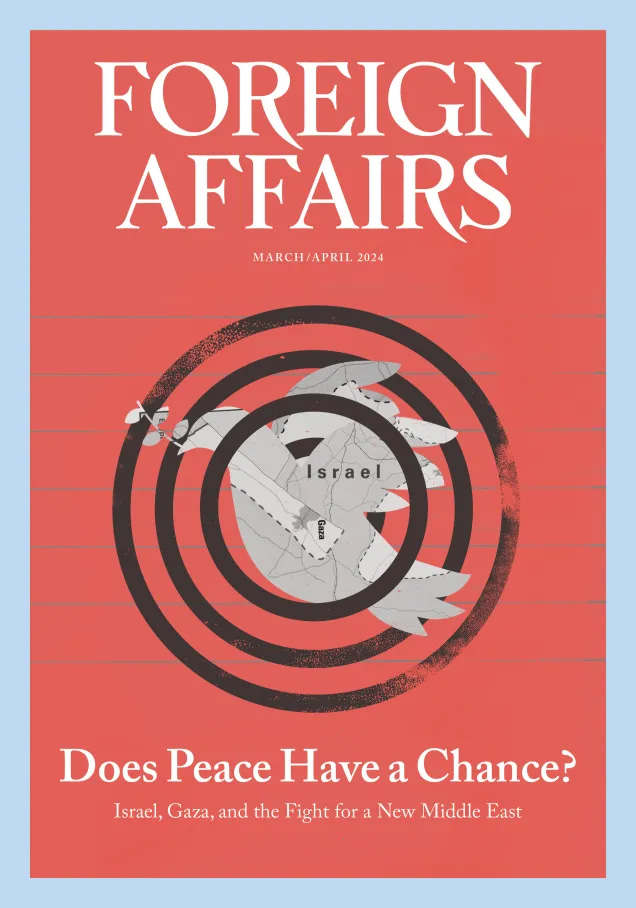The Two State Mirage
My new Foreign Affairs article argues to stop pushing for a two state deal which won't happen and focus on stopping the horrors that are actually happening.
Shibley Telhami and I have a new article (gift link without paywall here) in Foreign Affairs today addressing the remarkable surge over the last few weeks of talk about an Israeli-Palestinian two state solution somehow emerging from the ruins of Gaza. It’s become a talking point for the Biden administration, a bevy of European officials, and Arab officials alike (Israeli officials completely reject it, of course). There’s talk of aspirational recognition of a Palestinian state, despite its complete lack of any of the attributes of a state. It’s understandable, in a way: faced with the horrors of Israel’s war on Gaza, people need to find some hope to which to cling and want to feel like they are doing something. And they are right that nothing has changed in terms of what could be an acceptable final status between Israel and the Palestinians besides two states for two peoples. Martin Indyk, one of the most sincere and serious backers of this idea, makes his best case in the companion article to ours in Foreign Affairs - I recommend reading it carefully.
But under today’s conditions, calling for a return to two state diplomacy isn’t just a well-intentioned effort to make something positive out of a terrible reality. There is no chance at all that the war on Gaza will result in the creation of a viable Palestinian state. There was no chance before the war on Gaza either (as I argued last April, along with Michael Barnett, Nathan Brown and Shibley Telhami, in “Israel’s One State Reality”). The war has accelerated all of the trends which made that one state reality inescapable: it further decimated the authority and capacity of the Palestinian Authority, it accelerated Israeli settler land grabs in the West Bank, and it radicalized Israeli public opinion even farther against any notion of peace with the Palestinians. It has also killed over 30,000 Palestinians - some two-thirds of them women and children - and completely erased most of Gaza’s urban physical geography, including universities, schools, hospitals, and residential areas.
In the new issue of Foreign Affairs, Shibley Telhami and I argue (paywall free link here) that advocating a return to two state talks in this environment is little more than a fig leaf to cover up the refusal to do anything about the actually occuring atrocities in Gaza and the West Bank. Talking about a notional two state future is a way to avoid confronting the reality of the horrific devastation of Gaza after four and a half months of war and the rapid deterioration of the West Bank. And there’s no end in sight: Netanyahu continues to talk about attacking Rafah and its 1.4 million displaced civilians, while
the U.S. continues to veto U.N. resolutions calling for a ceasefire and continues to arm Israel even as it breaks all of Washington’s publicly articulated red lines, enabling Israel’s worst behavior while exercising little if any actual influence over its policies.
Here’s how Telhami and I frame the situation:
These calls to revive the two-state solution may come from good intentions. For years, a two-state solution has been the avowed goal of U.S.-led diplomacy, and it is still widely seen as the only arrangement that could plausibly meet the national aspirations of two peoples living in a single land. Establishing a Palestinian state alongside Israel is also the principal demand of most Arab and Western governments, as well as the United Nations and other international bodies. U.S. officials have therefore fallen back on the rhetoric and concepts of previous decades to find some silver lining in the carnage. With the unspeakable horrors of the October 7 attack and of the ongoing war on Gaza making clear that the status quo is unsustainable, they argue that there is now a window to achieve a larger settlement: Washington can both push the Israelis and the Palestinians to finally embrace the elusive goal of two states coexisting peacefully side by side and at the same time secure normalization between Israel and the Arab world.
But the idea of a Palestinian state emerging from the rubble of Gaza has no basis in reality. Long before October 7, it was clear that the basic elements needed for a two-state solution no longer existed. Israel had elected a right-wing government that included officials who were openly opposed to two states. The Palestinian leadership recognized by the West—the Palestinian Authority (PA)—had become deeply unpopular among Palestinians. And Israeli settlements had grown to the extent that creating a viable, contiguous Palestinian state had become almost impossible. For nearly a quarter century, there had also been no serious Israeli-Palestinian negotiations, and no major constituency in Israeli politics supported resuming them. Hamas’s shocking attack on Israel and Israel’s subsequent months-long obliteration of Gaza have only exacerbated and accelerated those trends.
The principal effect of talking again about two states is to mask a one-state reality that will almost surely become even more entrenched in the war’s aftermath. It would be good if the Israelis and the Palestinians could negotiate a peaceful division of land and people into two sovereign states. But they cannot. In repeated public statements in January, Israeli Prime Minister Benjamin Netanyahu made clear not just that he opposes a Palestinian state but also that there will continue to be, as he put it, “full Israeli security control over all of the territory west of the Jordan [River]”—land that would include East Jerusalem, the West Bank, and Gaza. In other words, Israel seems likely to continue to rule over millions of Palestinian noncitizens through an apartheid-like governance structure in which those Palestinians are denied full rights in perpetuity.
Read the whole thing for free at Foreign Affairs via this gift link, and then have at it!


